Adult learning statistics - characteristics of education and training
Data extracted in June 2021.
Planned article update: 25 June 2024.
Highlights
Participation rate in formal and non-formal education and training (last 12 months), 2016
This article presents an overview of European Union (EU) statistics related to learning statistics. Based on the adult education survey, it focuses on three main aspects of adult education and training: the most common fields; the relative importance of formal and non-formal education and training; and a more in-depth analysis of non-formal education and training, particularly concerning job-related non-formal learning activities.
This article is one of a set of statistical articles forming part of an online publication on education and training, and provides a complement to information in an article on adult learning. The data presented in this article are all derived from the adult education survey (AES).
Full article
Formal and non-formal adult education and training
About 44 % of adults aged 25–64 participated in some form of education or training
Among adults of working age (25–64), 43.7 % across the EU took part in formal or non-formal education or training in 2016. This marked an increase of 3.5 percentage points compared with the previous survey, which was conducted in 2011, when 40.2 % of the working-age population had participated in formal or non-formal education or training. In 2007, this share was 32.8 %.
In 2016, the majority of the non-formal education and training that was undertaken in the EU by people aged 25–64 was job-related rather than for personal fulfilment. Training courses, seminars, conferences and guided-on-the-job training are key elements for providing job-related training; while the latter type is usually very short, the other types tend to be of a slightly longer duration (typically one or two days). Guided-on-the-job training is characterised by planned periods of training, instruction or practical experience, using normal tools of work, either at the immediate place of work or in the work-situation with the presence of a tutor.
In the Netherlands and Sweden, the share of the working-age population participating in education and training rose to 64 %
Among the EU Member States, there was a considerable variation between the shares of adult working-age populations who participated in formal and non-formal education or training. In 2016, the highest proportions were recorded in the Netherlands (64.1 %) and Sweden (63.8 %), while 50–60 % of working-age adults in Denmark, France, Germany, Ireland, Finland, Hungary and Austria participated in some form of education and training. A small majority, 16 of the Member States recorded participation rates between 25 and 50 %, while Greece (16.7 %) and Romania (7.0 %) recorded much lower participation rates (see Figure 1).
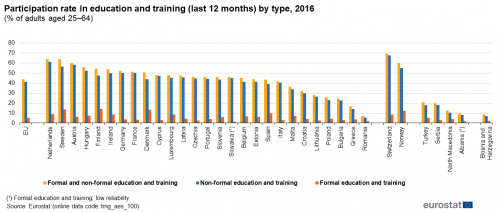
(% of adults aged 25–64)
Source: Eurostat (trng_aes_100)
Adult education and training by field of study
An analysis of the instruction hours spent by field of study reveals that in 2016 less than one fifth (17.5 %) of the formal and non-formal education and training that was given to adults aged 25–64 in the EU concerned business, administration and law. There were two fields of study which each accounted for around 15 % of the total hours spent by adults in instruction: services; and health and welfare. Arts and humanities; and engineering, manufacturing and construction were the only other fields to record double-digit shares.

(% share of total hours spent by adults aged 25–64 on formal and non-formal education and training)
Source: Eurostat (trng_aes_174)
Business, administration & law and health & welfare accounted for the biggest shares of adult education and training
Table 1 highlights that, while business, administration and law was the most popular field of study in terms of hours spent for adult education and training in the EU in 2016, with eight Member States recording their highest shares in this domain, health and welfare was just behind with seven Member States. Among the other Member States, five recorded highest shares in services, four in arts and humanities and two in engineering, manufacturing and construction (Estonia registering its highest share in both health & welfare and engineering, manufacturing and construction). The remaining two countries recorded high non response.
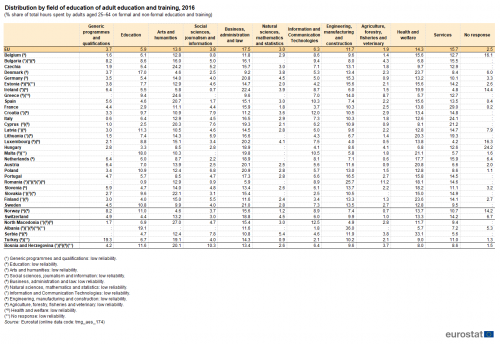
(% share of total hours spent by adults aged 25–64 on formal and non-formal education and training)
Source: Eurostat (trng_aes_174)
Adult education and training: relative importance of formal and non-formal instruction
Non-formal instruction is the most frequent type of education and training
The majority of adult education and training in the EU is non-formal education and training, in other words, outside of formal institutions of schools, colleges and universities. This is not surprising given that the age criterion for the AES is persons of working age (25–64 years-old), when most people have already completed their formal studies.
In 2016, more than two fifths (41.4 %) of the EU’s adult working-age population participated in non-formal education and training, a share that was more than eight times as high as the share of those who participated in formal education or training (5.0 %).
Formal education and training was relatively common in Finland (14.2 % of working-age adults), Sweden (13.8 %) and Denmark (13.5 %); all of the remaining EU Member States reported single-digit shares. By contrast, fewer than 3 % of adults aged 25–64 participated in formal education and training in Bulgaria, Czechia, Lithuania, Romania and Slovakia (see Figure 1).
A higher proportion of the instruction given in health and welfare was provided in a formal setting, while the opposite was true for services
Figure 3 provides an analysis of the relative importance of different fields of study in terms of instruction hours, contrasting formal and non-formal education and training. In 2016, health and welfare accounted for 18.8 % of the total number of hours adults spent in formal education and training in the EU compared with 11.5 % of hours spent in non-formal education and training.
Engineering, manufacturing and construction accounted also for a considerably higher proportion of the formal instruction hours of adults in the EU in 2016 (when compared with its share of non-formal instruction hours), while the relative share of services in non-formal instruction hours was considerably higher than its share in formal instruction hours. In a similar vein, social sciences, journalism and information as well as natural sciences, mathematics and statistics accounted for a relatively high share of the total number of hours of formal instruction that were given to adults, while arts and humanities, Information and Communication Technologies and generic programmes and qualifications accounted for relatively high shares of the total number of hours of non-formal education and training.
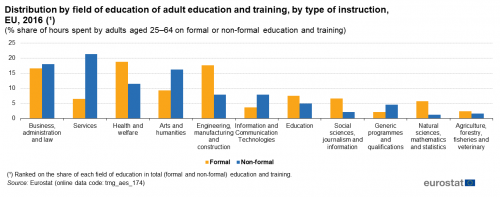
(% share of hours spent by adults aged 25–64 on formal or non-formal education and training)
Source: Eurostat (trng_aes_174)
Focus on non-formal adult education and training
The remainder of this article concentrates on the most common type of adult learning, non-formal education and training. The AES provides information on basically all non-formal learning activities in which an adult participated during the last 12 months. Therefore it is possible to analyse at the level of non-formal activities. The shares presented in this section are generally shown in relation to the total number of non-formal activities. Formal education and training of adults is not covered hereafter.
Relative importance of job-related non-formal adult education and training
In 2016, approximately four fifths (78.8 %) of the non-formal education and training activities of adults in the EU were job-related and almost one fifth (19.4 %) was not job-related; the remaining 1.8 % concerned non-formal activities where there was no response whether it was job-related or not.
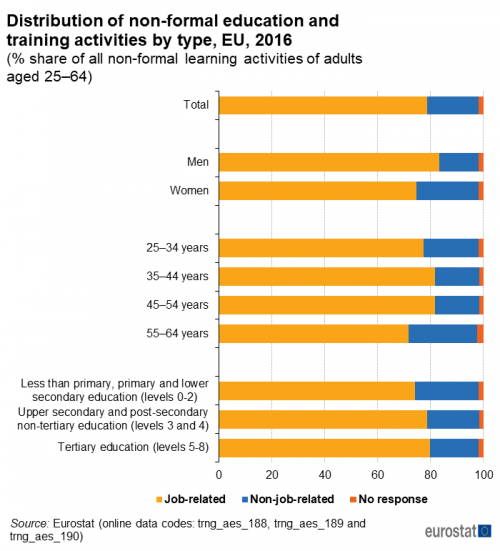
(% share of all non-formal learning activities of adults aged 25–64)
Source: Eurostat (trng_aes_188), (trng_aes_189) and (trng_aes_190)
The share of non-formal learning activities that was job-related ranged among the EU Member States from highs of more than 90 % in Slovakia, Lithuania and Bulgaria, down to 55.6 % in Hungary (see Table 2).
A higher proportion of non-formal learning activities of adult men rather than adult women was job-related
Within the EU in 2016, a high proportion (83.2 %) of non-formal learning activities of men was job-related. This share could be compared with the corresponding value for women, where just below three quarters (74.6 %) of all non-formal learning activities were job-related.
This gender gap was apparent in 26 EU Member States. The only exception was Cyprus, where the share of job-related non-formal learning activities was higher for women than for men: 79.3 % against 66.3 %.
In contrast, while 90.5 % of the non-formal learning activities of men in Greece were job-related, the corresponding share for women was 17.0 percentage points lower. This was the largest gender gap among the EU Member States, ahead of Italy (14.8 points difference), while France, Czechia and Malta all reported double-digit differences (again with a higher share of non-formal learning activities of adult men being job-related).
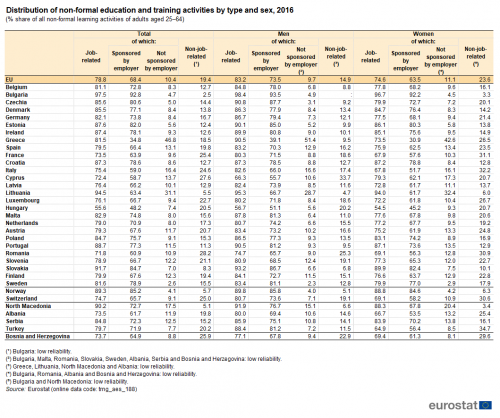
(% share of all non-formal learning activities of adults aged 25–64)
Source: Eurostat (trng_aes_188)
The share of non-formal education and training activities that were job-related tended to become slightly higher as people moved towards the 45–54 years age group
In 2016, the share of non-formal learning activities in the EU that was job-related rose slightly as a function of age from 77.3 % for those aged 25–34 to a peak of 81.7 % among those aged 45–54, before falling to 71.8 % among those aged 55–64. While considerably more than half of the non-formal learning of people aged 55–64 continued to be job-related, the relatively low shares for this age group suggest that some older persons were preparing for retirement by expanding their knowledge or skills in non-job related areas (see Figure 4).
The share of non-formal education and training activities that were job-related tended to be higher among adults with a tertiary level of educational attainment
An analysis by level of educational attainment (see Figure 4) suggests that adults in the EU with a tertiary level of educational attainment were more likely to follow some form of job-related education and training. In 2016, some 79.8 % of the non-formal learning activities of people aged 25–64 with a tertiary level of educational attainment (ISCED 2011 levels 5 to 8) were job-related, compared with 74.1 % among those with a low level of educational attainment (ISCED levels 0-2). At the same time, for adults with an intermediate educational attainment (ISCED levels 3-4) a share almost as high as for those with a tertiary education can be observed (78.6 %).
Figure 5 shows the relative contribution of sponsorship from employers to job-related non-formal education and training. In 2016, some 68.4 % of the non-formal education and training activities of adults were job-related and sponsored by employers, while 10.4 % of the activities were job-related and financially supported by other means.
With almost four fifths of all non-formal learning activities of adults in the EU being work-related, it is perhaps unsurprising to find that the vast majority of this was sponsored by employers providing financial support to their workforce in the form of training designed to improve the knowledge of their staff. The relatively high shares of education and training that are sponsored by employers may also be linked to the general affordability of training, which may be prohibitive for many people on an individual basis.
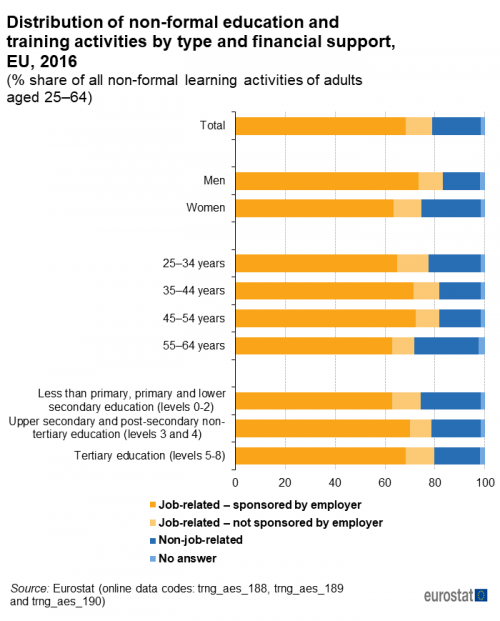
(% share of all non-formal learning activities of adults aged 25–64)
Source: Eurostat (trng_aes_188), (trng_aes_189) and (trng_aes_190)
A higher proportion of the non-formal education and training activities undertaken by men were job-related and sponsored by employers
A more detailed examination of these figures shows that employers provided financial support more often to male (rather than female) employees in order to follow job-related non-formal instruction. Almost three quarters (73.5 %) of the non-formal education and training activities followed by adult men in the EU were job-related and sponsored by employers, while among adult women the share was less than two thirds (63.5 %) — see Figure 5. Note these shares also reflect the lower proportion of women (than men) who participate in job-related non-formal education and training, which may, at least in part, be linked to lower employment rates among women; the EU employment rate for women aged 25–64 was 66.2 % in 2016, compared with a rate of 78.5 % for men of the same age.
The share of non-formal training activities followed by adults that were both job-related and sponsored by employers peaked at 92.8 % in Bulgaria and 84.7 % in Slovakia, reflecting their high shares of overall job-related non-formal education and training. In contrast, less than half of the non-formal instruction was both job-related and sponsored by employers in Hungary (48.2 %) and Greece (34.8 %).
The largest gender gaps for the share of adult non-formal instruction that was both job-related and sponsored by employers were recorded in Czechia and Italy, where the share for men was 15.0 and 14.3 percentage points higher than that for women. The gender gap was between 12.0 and 14.0 points (again in favour of men) in France, Latvia and Malta; even larger differences between the sexes were recorded in Turkey (24.8 percentage points).
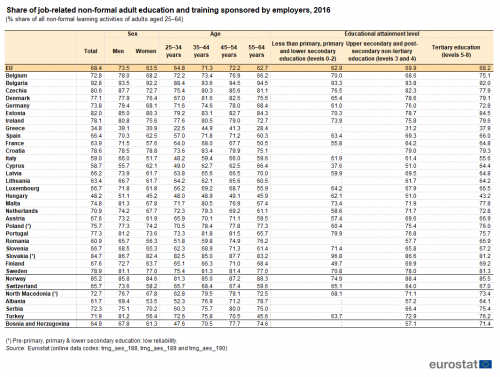
(% share of all non-formal learning activities of adults aged 25–64)
Source: Eurostat (trng_aes_188), (trng_aes_189) and (trng_aes_190)
A higher proportion of the non-formal education and training activities undertaken by those aged 45–54 were job-related and sponsored by employers
Across the EU in 2016, some 64.8 % of the non-formal learning activities followed by adults aged 25–34 were job-related and sponsored by employers (see Figure 5). This share rose to 71.3 % among those aged 35–44 and 72.2 % among those aged 45–54, before falling to 62.7 % for those aged 55–64. Note these figures reflect, to some degree, the relatively high proportion of non-formal education and training that was job-related among people aged 45–54. The initial increase with age may, at least in part, reflect the interest of employers and employees in keeping skills up-to-date, with this interest dropping off as employees get closer to the end of their working lives.
While the share of job-related non-formal education and training activities that were financed by employers rose as a function of age up to the 45–54 age group for the EU as a whole, there was a mixed picture among the EU Member States (see Table 3). In 2016, there were 13 Member States where the highest share of non-formal instruction that was both job-related and sponsored by employers was recorded among those aged 45–54. There were 10 Member States where the highest share was recorded for those aged 35–44 and five where the highest share was for those aged 55–64 (Bulgaria recorded the highest share for both 45-54 and 55-64).
In the absence of employer sponsorship, young adults were the most likely to undertake job-related education and training
In 2016, the share of non-formal education and training activities that were job-related but not sponsored by employers fell as a function of age (see Figure 5). This suggests that younger persons (25–34) were the most likely to undertake job-related non-formal instruction without employer sponsorship, while older persons (55–64) were the least likely (perhaps due to a shorter time horizon to benefit from any job-related education and training).
A similar analysis by educational attainment level (see Figure 5 and Table 3) shows that in 2016 a relatively high proportion (68.2 %) of the non-formal education and training activities undertaken in the EU by those with a tertiary level of education was job-related and sponsored by employers. An even higher share (69.9 %) was recorded for those with an intermediate educational attainment, whereas the share recorded among those with a low level of educational attainment was lower, at 62.9 %.
Within the EU in 2016, more than one fifth (22.6 %) of the non-formal job-related adult learning activities were within the field of business, administration and law. There were three other fields of study which accounted for double-digit shares: services (19.5 %), health and welfare (14.2 %) and Information and Communication Technologies (10.6 %) (see Figure 6).

(% share of all job-related non-formal learning activities of adults aged 25–64)
Source: Eurostat (trng_aes_166)
In 2016, across 17 of the EU Member States, more than one fifth of the non-formal job-related instruction was within the field of business, administration and law. This share peaked at 32.5 % in Sweden and was followed by Germany (28.5 %) and Cyprus (27.5 %) (see Table 4).
More than one fifth of the non-formal job-related adult learning activities were within services in eight of the EU Member States. This included Spain, with a share that was just above 20 %, while almost one third (32.9 %) of the non-formal job-related instruction in Hungary was in the field of services, a share that rose to around two fifths in Bulgaria (38.5 %) and Slovakia (43.5 %).
There was also more than one fifth of job-related non-formal instruction of adults given over to health and welfare in Malta and Ireland. Another 21 EU Member States recorded shares that were in double-digits, and only Romania, Greece, Bulgaria and Hungary reported shares below 10 %.
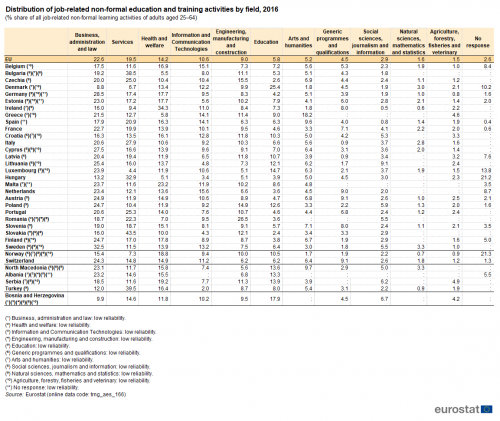
(% share of all non-formal learning activities of adults aged 25–64)
Source: Eurostat (trng_aes_166)
Source data for tables and graphs
Data source
The adult education survey (AES) is the source of all information in this article. The AES covers adults’ participation in education and training (formal, non-formal and informal learning) and is one of the main data sources for EU lifelong learning statistics. It covers adults of working-age (25–64 years) and refers to all learning activities in which respondents may have participated during a 12-month period prior to the interview.
Three waves of the AES have been implemented so far, in 2007, 2011 and 2016. The first was a pilot exercise and was carried out on a voluntary basis, while the 2011 and 2016 AES were underpinned by legal acts (Commission Regulation (EU) No 823/2010 and Commission Regulation (EU) No 1175/2014). The next AES is due in 2022/23 (Commission Implementing Regulation (EU) 2021/861).
Classification
The fields of education and training are derived from the International standard classification of education (ISCED)-F.
The first results based on ISCED-F 2013 were published with data for the 2016 reference period; data up to 2011 are based on ISCED 1997 (fields).
Key concepts
The fundamental criterion to distinguish learning activities from non-learning activities is that the activity must be intentional (and not by chance — ‘random learning’), in other words, a deliberate search for knowledge, skills, competences or attitudes.
Learning activities may be defined through a classification which provides operationalization and guidelines in particular for non-formal education and training - named classification of learning activities (CLA) - as follows:
- Formal education and training is defined as ‘education that is institutionalised, intentional and planned through public organisations and recognised private bodies and — in their totality — constitute the formal education system of a country’ [1];
- Non-formal education and training is defined as any organised and sustained learning activities outside the formal education system. The CLA further distinguishes the following broad categories of non-formal education:
- non-formal programmes;
- courses (which are further distinguished into classroom instruction, private lessons and combined theoretical-practical courses including workshops);
- guided-on-the-job training.
Non-formal education therefore takes place both within and outside educational institutions and may cater for people of all ages. It covers educational programmes and training to impart literacy, life skills, work skills, and general culture.
- Informal learning is less organised and less structured. It may include learning events that occur in the family, in the workplace, and in the daily life of every person, for example, coaching/informal tuition, guided visits, self-learning, learning groups or practice. Note that informal learning is not covered by this article.
Tables in this article use the following notation:
- Value in italics: data value is forecasted, provisional or estimated and is therefore likely to change;
- ':' not available, confidential or unreliable value.
Context
Adults with a low level of educational attainment and a lack of skills are more likely to earn lower than average wages and are more vulnerable to the precarious nature of the labour market. These individuals often suffer from a lack of basic skills that are increasingly considered as essential for a modern-day economy: literacy, numeracy and technological skills (‘digital literacy’). Indeed, in a world that is increasingly characterised by technological change and more precarious employment opportunities, it becomes increasingly unlikely that people can rely on the skills they acquire at school/university to last them until the end of their working lives.
There are a variety of paths that people can potentially follow to gain additional education and training beyond the formal education and training system. Lifelong learning strategies imply investing in people and knowledge — promoting the acquisition of basic skills and providing opportunities for innovative, more flexible forms of learning. They aim to provide people of all ages with equal access to high-quality learning opportunities, and to a variety of learning experiences designed to increase employability, social inclusion and active citizenship.
For some people the decision to re-engage in education and training is a difficult one: it is therefore likely that a range of different approaches are required to offer participants flexible pathways. These may comprise formal, non-formal and informal learning, so that individual’s engage in up-skilling or re-skilling to improve their employment opportunities and lives in general. On the one hand, investment in adult skills has the potential to improve an individual’s quality of life by raising potential earnings, increase their job satisfaction and job opportunities, or promote their social mobility. From a policy perspective, adult education and training has the potential to help the EU to boost its competitiveness in globalised markets, develop a more highly-skilled workforce to meet employers’ demands, keep an ageing workforce productive and move people out of welfare. Such developments are increasingly important in a global context, given the rapid increase in the level of educational attainment and skills among the workforces of emerging and developing economies.
In the Porto Social Commitment of 7 May 2021, the European Parliament, the Council of the EU, the European social partners and civil society organisations endorsed the target that at least 60 % of all adults should participate in training every year by 2030.
The European Skills Agenda outlines a five-year plan to help individuals and businesses develop more and better skills and to put them to use. Actions of the skills agenda also refer to tools and initiatives to support people in their lifelong learning pathways.
Within the European employment strategy Council decision (EU) 2020/1512 recently revised the employment guidelines. Guideline 6 concerns “enhancing labour supply and improving access to employment, skills and competences”. Amongst others, this guideline calls Member States to enable everyone to anticipate and better adapt to labour-market needs, in particular through continuous upskilling and reskilling.
Direct access to
- The EU has reached its target for share of persons aged 30 to 34 with tertiary education — news release April 2019
- Key data on education in Europe 2012 — statistical book
- Significant country differences in adult learning — Statistics in focus 44/2009
- Education and training, see:
- Participation in education and training (educ_part)
- Adult learning (trng)
- Participation in education and training (last 12 months) (trng_aes_12m0)
- Participation rate in education and training by sex (trng_aes_100)
- Participation rate in education and training by age (trng_aes_101)
- Participation rate in education and training by educational attainment level (trng_aes_102)
- Participation rate in job-related non-formal education and training by type and sex (trng_aes_120)
- Distribution of education and training activities by field (ISCED-F 2013) (trng_aes_166)
- Distribution of non-formal education and training activities by type and sex (trng_aes_188)
- Distribution of non-formal education and training activities by type and age (trng_aes_189)
- Distribution of non-formal education and training activities by type and educational attainment level (trng_aes_190)
- Time spent on education and training (last 12 months) (trng_aes_12m2)
- Distribution of instruction hours by field (ISCED-F 2013) (trng_aes_174)
- Participation in education and training (last 12 months) (trng_aes_12m0)
Metadata
- Adult education survey (ESMS metadata file — trng_aes_12m0_esms)
Manuals and other methodological information
- European Commission — Skills agenda
- European Commission — Education and training — adult learning
- European Commission — Education and training — Electronic Platform for Adult Learning in Europe (EPALE)
- European Commission — European Education Area
- European Commission — Education and training — vocational education and training
- European Commission — EU Skills Panorama
Notes
- ↑ International Standard Classification of Education 2011, paragraph 36, page 11.